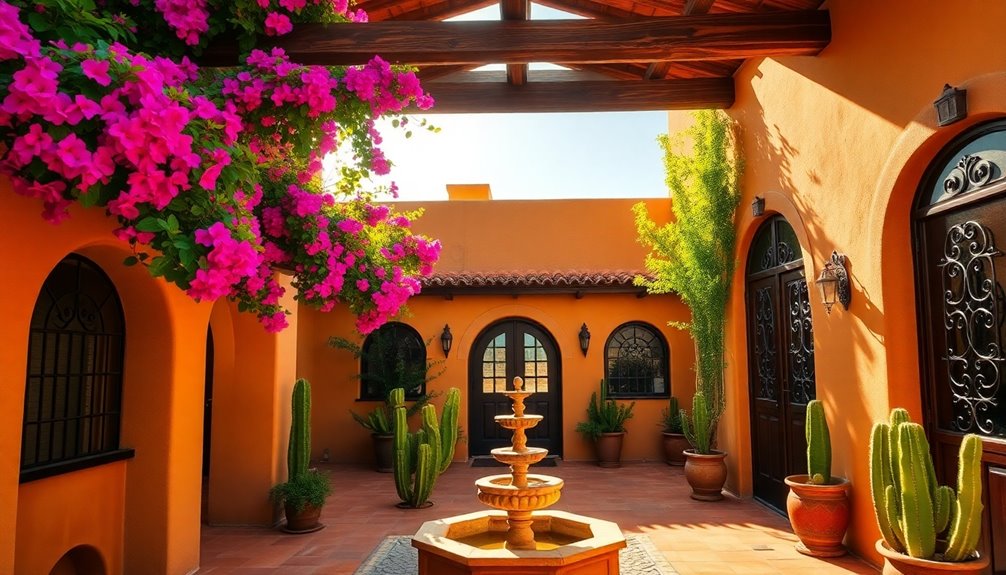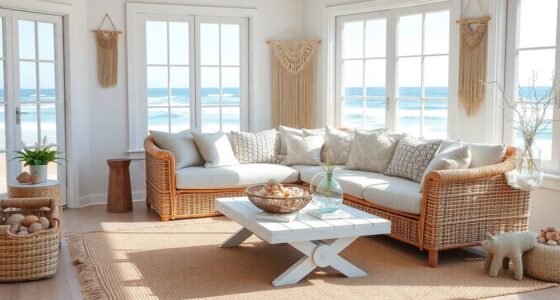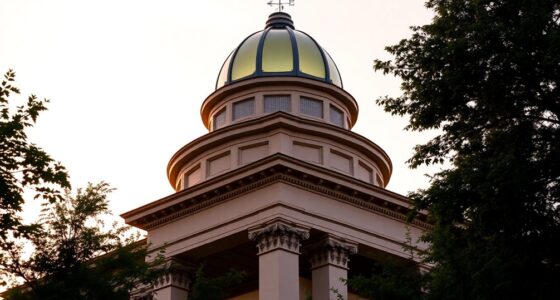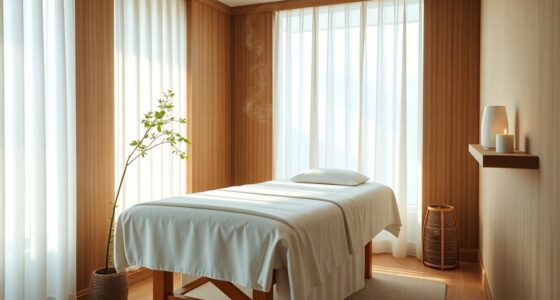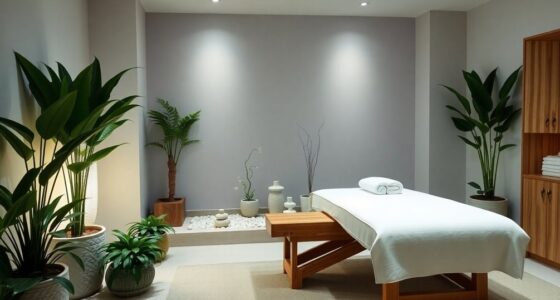A hacienda-style home blends rich Spanish-inspired design with practicality. You'll notice thick adobe walls that offer excellent insulation, while red-tiled roofs add to its charm. Arched doorways and large windows create elegant connections between indoor and outdoor spaces, often centered around a lush courtyard. Inside, open floor plans and warm earth tones foster a cozy atmosphere, perfect for gatherings. These homes also showcase sustainable materials and smart modern technology, ensuring comfort and eco-friendliness. If you want to explore how these elements come together in hacienda living, there's much more to discover.
Key Takeaways
- Hacienda style homes feature thick adobe walls and red-tiled roofs, providing excellent insulation and energy efficiency.
- The design combines Spanish, Moorish, and Native American influences, reflecting a rich cultural heritage.
- Interior layouts often include open floor plans and warm earthy color palettes, fostering a cozy and inviting atmosphere.
- Central courtyards serve as vibrant outdoor living spaces, enhancing relaxation and social interactions.
- Modern adaptations incorporate sustainable building practices and smart home technology while maintaining traditional architectural elements.
Architectural Features of Hacienda Homes
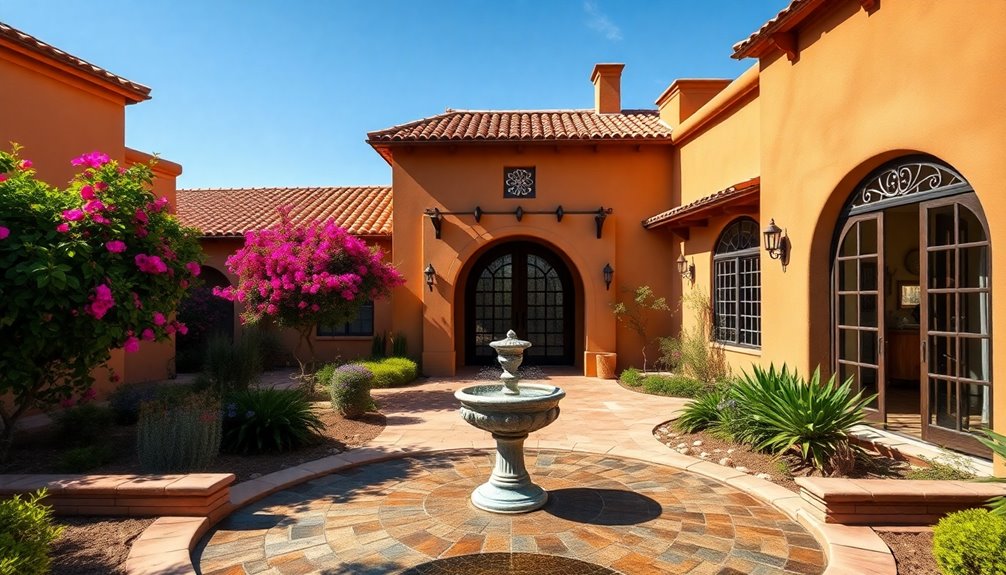
When you step into a hacienda style home, you'll immediately notice its distinctive architectural features that blend beauty with functionality.
The thick adobe walls provide exceptional insulation, keeping the interior cool in hot climates. Red-tiled roofs not only enhance the aesthetic appeal but also contribute to energy efficiency.
You'll find arched doorways and windows, which add elegance and a timeless quality to the space, often adorned with decorative wrought iron accents.
Central courtyards serve as a hallmark of hacienda design, offering private retreats surrounded by lush landscaping and tranquil water features.
Hand-painted Talavera tiles and rustic wood beams enrich the charm of these homes, reflecting a rich cultural heritage that invites you to appreciate their unique craftsmanship.
Historical Origins of Hacienda Style

The rich architectural features of hacienda style homes are rooted in their historical origins, which trace back to colonial Mexico in the 16th century. Initially, these large estates served agricultural, mining, and cattle ranching purposes, reflecting the wealth of landowners.
The design combines Spanish, Moorish, and Native American influences, creating unique structures that cater to local climates and cultural needs. By the 17th and 18th centuries, haciendas became essential to community life, symbolizing economic power and cultural heritage.
The popularity of hacienda style homes surged in the U.S. during the 1920s and 1930s, fueled by the Spanish Colonial Revival movement and the 1915 Panama-California Exposition.
Today, these homes continue to inspire modern adaptations, emphasizing their lasting significance.
Cultural Influences on Design
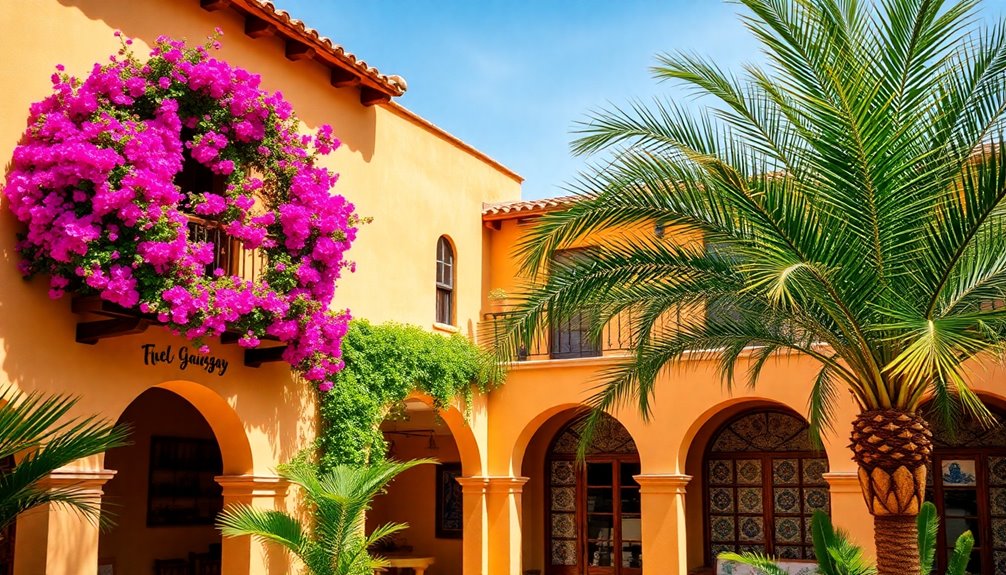
While exploring hacienda style homes, you'll notice how deeply cultural influences shape their design. Originating in colonial Mexico, these homes blend Spanish colonial architecture with indigenous elements, showcasing practical adaptations to the environment.
The thick adobe walls and red-tiled roofs reflect the needs of hot, arid climates, highlighting the agricultural and ranching roots of this style. Moorish architecture further enhances the aesthetic, with arched doorways and intricate tile work that marry beauty and function.
The 20th-century revival of hacienda homes in the American Southwest taps into nostalgia and romanticized views of Spanish heritage, emphasizing their cultural significance. Artisanal craftsmanship, seen in handcrafted ironwork and Talavera pottery, enriches the narrative woven into hacienda design, celebrating its historical significance.
Interior Design Elements

In hacienda style homes, you'll love the open floor plans that create a seamless flow between spaces.
The warm earthy color palettes paired with rustic furnishings and textiles invite a cozy atmosphere that feels both welcoming and comfortable.
Together, these elements enhance the charm and functionality of your living environment.
Open Floor Plans
Open floor plans in hacienda-style homes create an inviting atmosphere that encourages interaction and flow between spaces. These designs promote spaciousness, allowing you to move freely between the kitchen, dining, and living areas.
The large windows and doors enhance indoor-outdoor living, connecting your interior with beautiful courtyards and gardens. Rustic materials like exposed wooden beams and clay tiles add warmth and charm, making the environment feel cozy and welcoming.
Plus, the versatile layout accommodates everything from family gatherings to entertaining guests, reflecting a modern take on traditional hacienda living. By maintaining defined yet interconnected areas, you can enjoy functionality without sacrificing style, perfectly blending comfort and elegance in your home. Additionally, using durable materials can help ensure that your hacienda retains its beauty and charm over the years.
Earthy Color Palettes
Embracing earthy color palettes is essential for capturing the essence of hacienda-style homes. These designs typically showcase warm earthy tones like terracotta and deep browns, reflecting the traditional rustic charm of natural materials.
To create a harmonious atmosphere, consider these key elements:
- Warm Neutrals: Use shades of beige and cream to provide a soothing backdrop.
- Vibrant Accents: Incorporate rich reds, deep blues, and lively greens for visual interest that celebrates cultural heritage.
- Handcrafted Details: Add colorful, bold-patterned tiles that enhance the earthy aesthetic without overpowering the space.
Rustic Furnishings and Textiles
To fully capture the warmth and charm of hacienda-style homes, rustic furnishings and textiles play a vital role in creating inviting interiors. You'll find distressed wood pieces, like tables and chairs, that reflect traditional craftsmanship. Textiles showcase earthy palettes and vibrant patterns, enhancing comfort and visual appeal. Handcrafted elements, such as locally sourced pottery and artisan textiles, emphasize cultural heritage. Additionally, the use of natural materials in decor promotes authenticity and a connection to the surrounding environment.
| Rustic Furnishings | Textiles | Handcrafted Elements |
|---|---|---|
| Distressed wood tables | Earthy color palettes | Locally sourced pottery |
| Vintage leather chairs | Vibrant woven fabrics | Artisan-made textiles |
| Exposed wood beams | Decorative accents | Talavera pottery tiles |
These elements work together to create a harmonious and cozy hacienda atmosphere.
Landscaping and Outdoor Areas
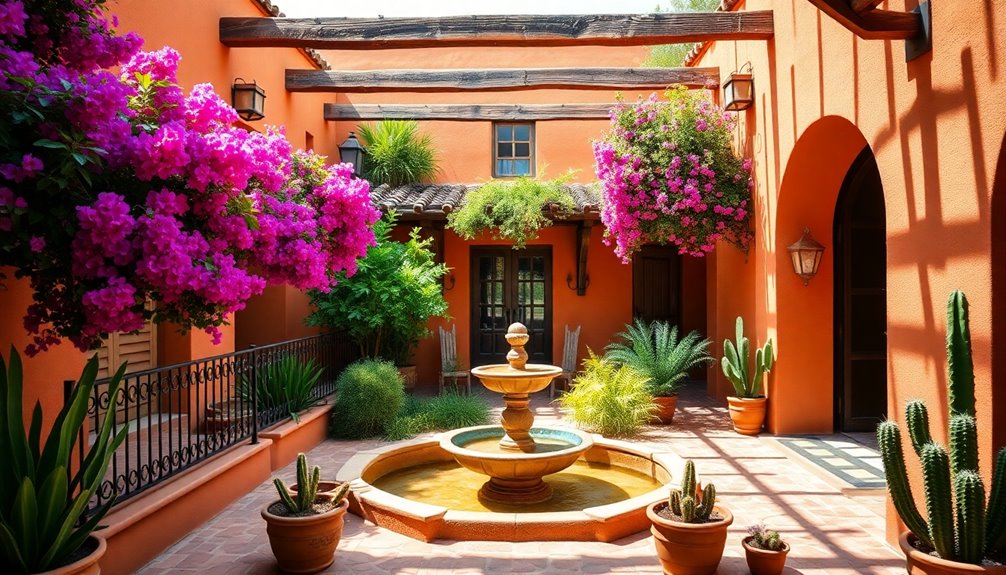
When you think about Hacienda landscaping, imagine vibrant outdoor living spaces that invite relaxation and gatherings.
By choosing sustainable plants that thrive in your climate, you not only enhance the beauty of your home but also support the environment.
Let's explore how to create these inviting areas that blend functionality with nature.
Outdoor Living Spaces
While outdoor living spaces play an essential role in hacienda style homes, they invite you to relax and socialize in a beautifully designed environment.
Central courtyards serve as the heart of these homes, seamlessly blending indoor and outdoor areas. To enhance your outdoor experience, consider these key elements:
- Water Features: Incorporate fountains or ponds for a calming ambiance.
- Lush Vegetation: Choose native and drought-resistant plants to create a vibrant landscape.
- Comfortable Structures: Add pergolas or shade structures for relaxation and shade.
With stone pavings, decorative tilework, and terracotta pots, your outdoor spaces will feel inviting.
Enjoy the tranquil atmosphere that these features bring, making your hacienda a perfect gathering spot.
Sustainable Plant Choices
Creating a sustainable landscape around your hacienda-style home not only enhances its beauty but also supports environmental health.
Focus on sustainable plant choices by incorporating native and drought-resistant plants like succulents and cacti. These plants thrive in arid climates, reducing the need for excessive water. Mediterranean flora, such as olive trees and bougainvillea, adds aesthetic appeal while being well-suited for warm, dry conditions.
Utilize xeriscaping techniques to design visually appealing gardens that require minimal irrigation.
Enhance your outdoor spaces with terracotta pots and tilework, which conserve water and align with hacienda aesthetics.
Finally, consider adding shade structures like pergolas to protect your outdoor living areas, allowing lush vegetation to flourish and contribute to the rustic charm of your hacienda home. Incorporating eco-friendly practices in your landscape design can further enhance the sustainability of your outdoor environment.
Types of Hacienda Style Homes

Hacienda style homes come in a variety of designs, each with its own unique charm and character.
Whether you're drawn to the rustic elegance of traditional haciendas or the sleek sophistication of modern haciendas, there's a style for every taste.
Here are three popular types:
- Traditional Hacienda: Features central courtyards, thick adobe walls, and red-tiled roofs, showcasing artisanal tilework.
- Modern Haciendas: Combines minimalist designs with large glass windows and eco-friendly materials while keeping the open courtyard concept.
- Coastal Hacienda: Perfect for beach settings, this style uses humidity-resistant materials and encourages outdoor living.
Each type reflects the rich heritage of hacienda style homes, blending functionality with timeless aesthetics.
Modern Adaptations and Trends

As you explore modern hacienda style homes, you'll notice a strong emphasis on sustainable building practices that prioritize eco-friendly materials and energy efficiency.
Smart home integration is also on the rise, offering you the charm of traditional design combined with the conveniences of today's technology.
These adaptations not only enhance your living experience but also reflect a commitment to environmentally conscious choices.
Sustainable Building Practices
While traditional Hacienda styles evoke a rich cultural history, modern adaptations are embracing sustainable building practices that prioritize environmental responsibility.
You can enjoy the beauty of these homes while also considering the planet. Here are three key features to look for:
- Eco-friendly materials: Reclaimed wood and low-VOC paints minimize environmental impact during construction and design.
- Energy efficiency: Solar panels and high-performance insulation enhance energy conservation, reducing utility costs.
- Drought-resistant landscaping: Utilizing native plants not only beautifies your outdoor space but also lowers water consumption. Additionally, incorporating solar-powered irrigation systems can further improve water efficiency in maintaining these landscapes.
Smart Home Integration
Embracing the charm of traditional architecture doesn't mean sacrificing modern conveniences; smart home integration is revolutionizing how you experience Hacienda-style living.
In today's modern Hacienda designs, smart home technology allows you to control lighting, climate, and security systems remotely, enhancing your convenience and energy efficiency.
You'll find energy-efficient features like solar panels and smart thermostats, promoting sustainability while preserving the rustic aesthetic you love.
Automated irrigation systems manage your garden's water needs efficiently, respecting the drought-resistant principles of Hacienda design.
Plus, smart appliances seamlessly blend into your interior, providing modern functionality without compromising traditional charm.
This fusion of old-world elegance with cutting-edge technology is attracting buyers who appreciate authenticity and the comforts of contemporary living. Additionally, smart utilities for home enhance energy efficiency and comfort, making it easier to maintain a sustainable lifestyle.
Benefits of Hacienda Living

Living in a hacienda-style home offers a unique blend of comfort and community that appeals to many.
These homes are designed for modern living, providing several advantages that enhance your lifestyle:
- Energy Efficiency: Thick adobe walls guarantee excellent insulation, keeping temperatures stable and reducing energy costs.
- Open Floor Plans: The layout promotes seamless indoor-outdoor living, fostering social interactions among family and friends.
- Central Courtyards: These private outdoor retreats are perfect for relaxation and gatherings, surrounded by lush landscaping and tranquil water features.
With their rustic charm and eco-friendly landscaping, hacienda style homes not only create a welcoming atmosphere but also connect you with nature while enhancing your sense of community.
Materials and Construction Techniques

Hacienda-style homes showcase a rich blend of traditional and modern materials, creating a unique aesthetic and functional appeal. They primarily utilize thick adobe or stucco walls, offering excellent insulation and durability for hot climates. The roofs, often made of red terracotta tiles, enhance both beauty and energy efficiency. Rustic construction techniques incorporate exposed wooden beams and handcrafted ironwork, adding authenticity to each design. Small, strategically placed windows reduce heat gain while ensuring privacy. Regular cleaning and maintenance of these materials can support a healthier lifestyle by promoting cleanliness and hygiene.
| Material | Purpose |
|---|---|
| Adobe/Stucco | Insulation and durability |
| Terracotta Tiles | Aesthetic and energy efficiency |
| Wooden Beams | Structural support and charm |
| Ironwork | Decorative and functional accents |
| Sustainable Materials | Modern energy-efficient features |
Notable Examples and Case Studies

While exploring notable examples of hacienda-style homes, you'll find a diverse array of designs that highlight the architectural richness of this style.
Here are three standout cases:
- Mission San Luis Rey, California – This historic site showcases traditional adobe architecture with expansive courtyards, reflecting the style's origins.
- Hacienda at the 1915 Panama-California Exposition, San Diego – A prime example of the Spanish Colonial Revival movement, it influenced many hacienda designs across the U.S.
- Las Campanas, Santa Fe – This luxurious development blends modern amenities with traditional adobe construction, appealing to those seeking cultural authenticity.
Each of these notable examples illustrates how hacienda homes beautifully merge history and modernity while staying true to their roots.
Frequently Asked Questions
What Is the Spanish Hacienda Style?
The Spanish hacienda style is all about warmth and charm.
You'll notice thick adobe walls and red-tiled roofs that create a cozy atmosphere. Arched doorways and central courtyards invite natural light, while lush landscaping enhances outdoor living.
Inside, rustic furnishings and handcrafted details, like Talavera pottery and exposed wood beams, reflect traditional craftsmanship. The warm, inviting atmosphere is complemented by the artful arrangements of vibrant textiles that add splashes of color to the earthy tones of the space. Drawing inspiration from the modern design of bahay kubo, the layout emphasizes open spaces and natural light, creating a seamless connection with the outdoors. This harmonious blend of old and new not only celebrates cultural heritage but also provides a refreshing take on contemporary living.
This style beautifully blends history with modern comforts, making it a unique choice for any home.
What Makes a House a Hacienda?
When you think of a hacienda, picture a warm embrace of sun-soaked walls and inviting arches.
A house becomes a hacienda through its thick adobe or stucco walls, red-tiled roofs, and central courtyard that draws you outdoors.
You'll find rustic details like handcrafted tiles and exposed beams, creating an atmosphere of authenticity.
With open floor plans, these homes blur the lines between indoor and outdoor living, making nature an integral part of your daily life.
What Is the Spanish Hacienda?
The Spanish hacienda is a distinctive architectural style that emerged in the 16th century during colonization.
You'll notice its thick adobe walls, red-tiled roofs, and arched doorways, creating a warm, inviting atmosphere.
Central courtyards often serve as gathering spaces, blending indoor and outdoor living.
Rich in history, these homes showcase intricate tile work and artisanal craftsmanship, reflecting a mix of Spanish and Native American influences that continue to captivate homeowners today.
What Does Hacienda Look Like?
When it comes to hacienda style, you're stepping into a world of charm and warmth.
You'll notice thick adobe walls and low-pitched red-tiled roofs that scream Spanish elegance. Arched doorways beckon you inside, while central courtyards invite tranquility with lush gardens.
Inside, open floor plans and rustic furnishings create a cozy atmosphere. You can't miss the decorative tiles and wooden beams that add character, making you feel right at home.
Conclusion
In summation, Hacienda homes harmoniously blend history, culture, and comfort, creating enchanting spaces that celebrate Spanish-inspired design. Their striking structures and serene settings serve as a sanctuary for those seeking solace. With modern adaptations maintaining their charm, these dwellings deliver delightful living experiences. Whether you're drawn to their architectural allure or vibrant outdoor spaces, embracing Hacienda style can enrich your lifestyle, fostering a fulfilling fusion of tradition and tranquility. Discover the beauty and benefits today!
